We may earn revenue from the products available on this page and participate in affiliate programs. Learn More ›
The 22 ARC is an interesting cartridge that occupies a specific niche. The promise it makes is to deliver .22-250 Remington performance from a round that feeds through AR-15 pattern rifles and magazines.
In addition, it has a case design that accommodates heavy-for-caliber .224 bullets that are optimized for long-range shooting and hunting medium sized game.
It has a couple other tricks up its sleeve, too. The cartridge is tuned to work well in certain competitive shooting games—think run-and-gun sniper matches—and for hunting predators at night with thermals.
The 22 ARC is going to have to fight for its place at the table, however. The field of high performance .22-caliber centerfire cartridges is crowded and includes beloved classics like the .22-250 Remington and .223 Remington, as well as relative newcomers like the 22 Nosler, 22 Creedmoor, and 224 Valkyrie.
22 ARC Specs
- Bullet Diameter: .224 inches
- COL: 2.260 inches
- Case Length: 1.525 in.
- Case Head: .441 inches
- Shoulder Angle: 30 degrees
- Twist: 1:7
- SAAMI Max Pressure: 52,000 psi
22 ARC Review Highlights
- Minimal recoil
- Equals or betters .22-250 performance through a shorter barrel
- Offers “point, shoot, and hit” performance on targets at extended ranges
- Factory ammo delivered very good accuracy and consistent velocities
- Average accuracy with 5-shot groups at 100 yards: 0.852 inches
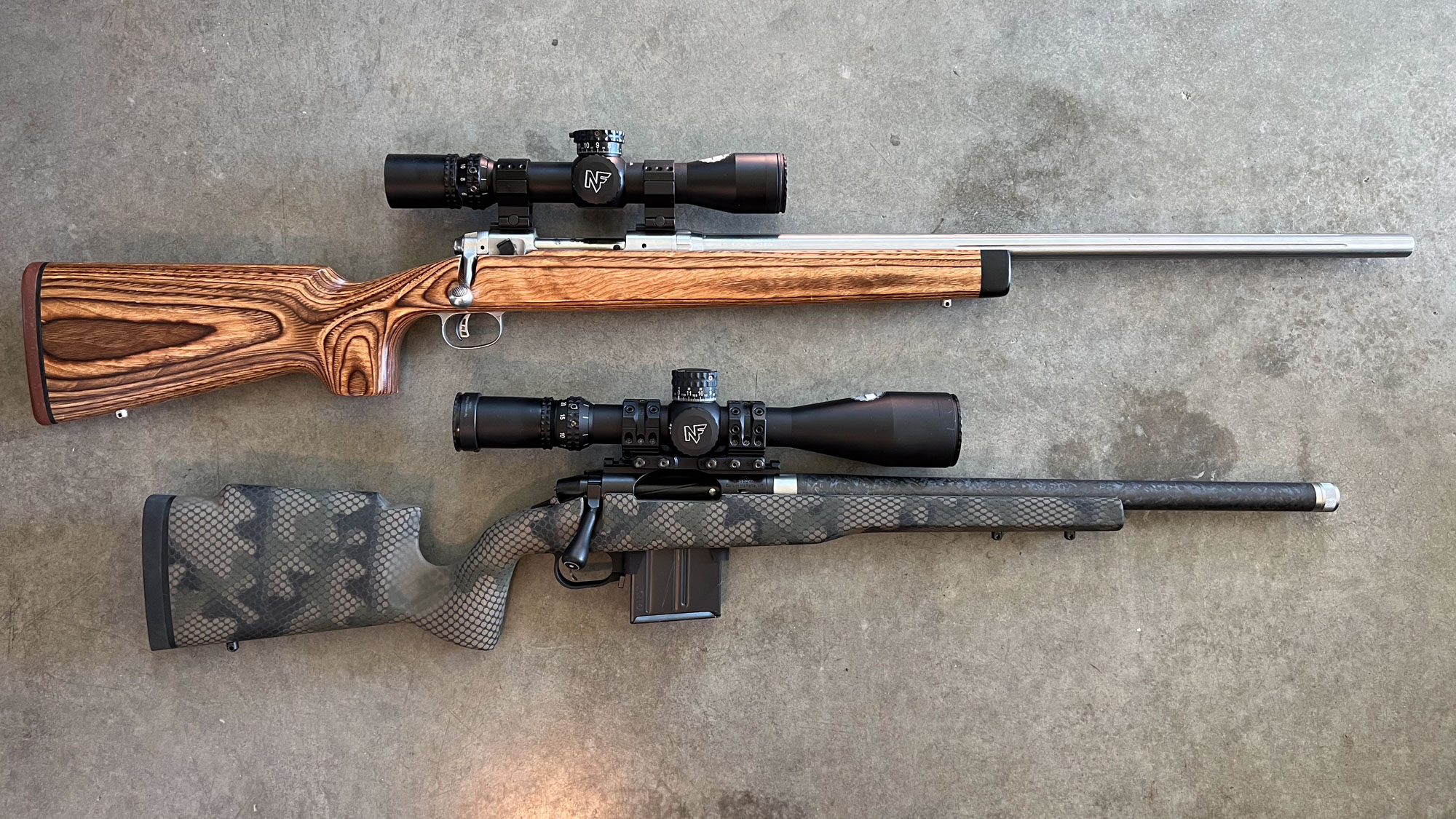
History of the 22 ARC
The 22 ARC has an interesting origin story. You might reasonably assume that it is a spin-off from the 6mm ARC, which Hornady introduced in 2020. But you’d be wrong.
The 22 ARC predates the 6mm ARC and can trace its lineage through the 6.5 Grendel, which is the parent case for both ARCs.
Ballistic tinkerers have been necking down the 6.5 Grendel to .22-caliber for many years, and one person who embraced the 22 Grendel wildcat was Greg Hamilton, Director of Special Projects at Proof Research.
Hamilton is a top competitive shooter, particularly in the realm of dynamic two-person sniper matches, and looked at the cartridge as a way to get maximum performance from an AR-15.
He wanted an accurate .224-caliber round with excellent downrange ballistics that could engage arrays of distant targets quickly without the need to range each piece of steel.
His experimentation led him to neck down 6.5 Grendel brass and pair it with Hornady’s 75-grain ELD-M bullet.
The first group he put downrange with the 75-grainers—on November 18, 2018—measured .570 inches at 3136 fps out of a 22-inch barrel. What makes that even more impressive is that it was a ladder test with CFE223 and the group had an extreme spread of 120 fps. The cartridge was off to a good start.

In competition, the wildcat delivered on its promise. Hamilton was able to hold high, or just slightly over, steel targets and score hits thanks to the forgiving nature of the round’s trajectory.
For instance, based on his data, if you zero a rifle 2.5 inches high at 100 yards, it will be dead on at 275 yards and be just 8 inches low at 375 yards. A two-thirds IPSC target measures 12 inches wide by 20 inches tall and is a typical type of target encountered in field sniper matches. So by holding on the target’s head you would be able to score hits at 450 yards without any need to dial or range. Of course, you could modify your zero offset as needed for specific scenarios, but you get the idea.
Potential for Hunting
Hamilton worked with Hornady throughout his experimentation, and his counterparts there identified opportunities for the round beyond the competition realm.
The qualities that the yet-to-be-named 22 ARC brought to sniper matches also translate to hunting and that’s where Hornady saw the bigger play.
A specific niche that the 22 ARC is optimized for is hunting coyotes at night. Picture a pack of coyotes moving toward your call in the dark and trying to circle downwind, as they always do. You can never count on them standing still for more than a second or two, and you’ll rarely know their exact range, which is especially hard to discern through the flat image generated by thermals and night vision.
To augment the 22 ARC’s virtues for this (and other) types of hunting, Hornady created a new projectile.
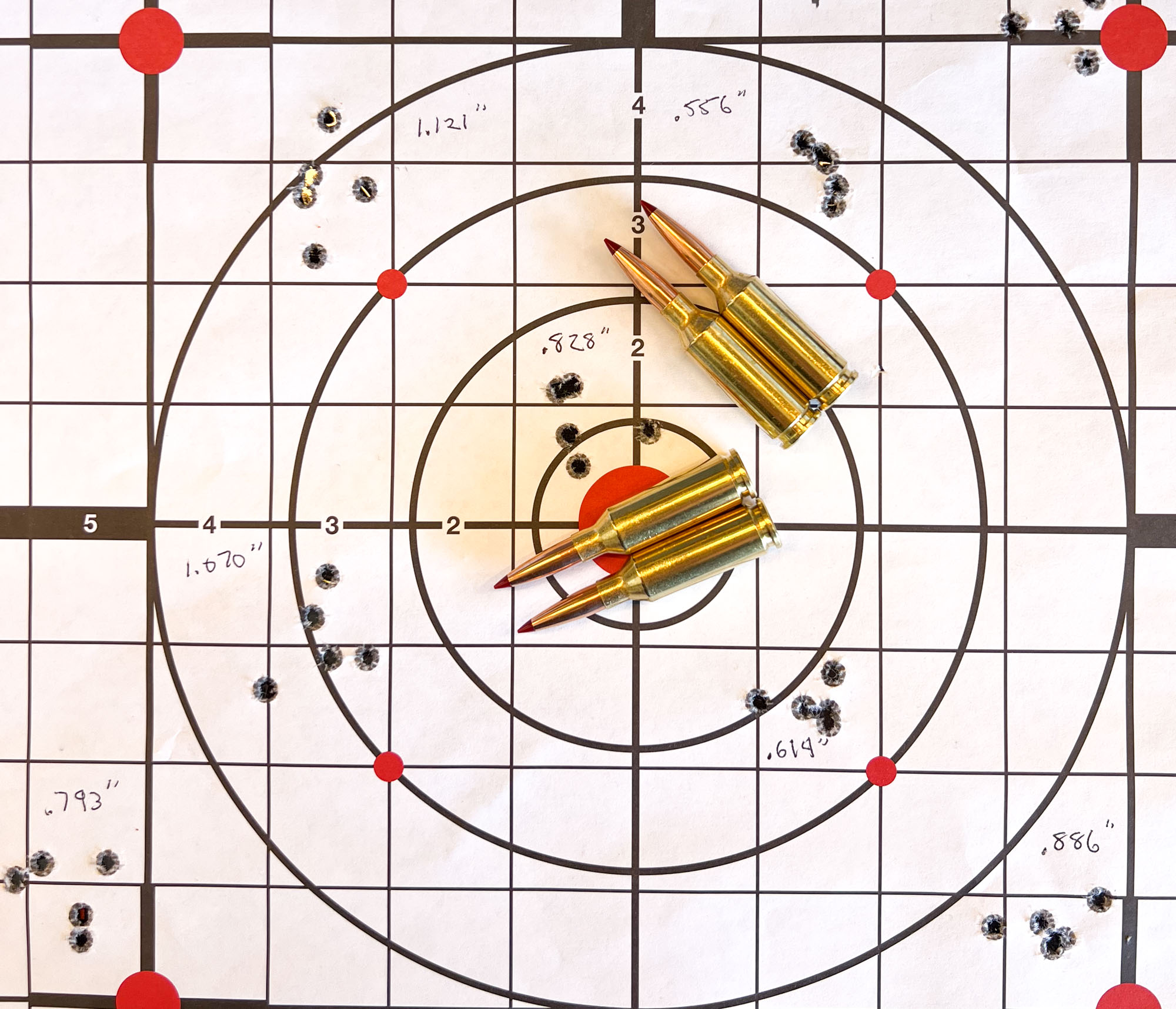
Hornady 62-grain ELD-VT: The 22 ARC’s Secret Sauce
When Hornady announced the 22 ARC last fall it indicated it would be available in three factory loads: the 88-grain ELD-M, the 75-grain ELD-M, and a new projectile, the 62-grain ELD-VT.
The ELD nomenclature stands for “extremely low drag” and the three flavors of ELD bullets in the Hornady ecosystem are match bullets (ELD-M), expanding hunting bullets (ELD-X), and the new varmint/target series (ELD-VT).
What’s interesting about the 62-grain ELD-VT is that it is designed with a substantial hollow cavity behind the polymer tip. By removing that lead, the bullet maintains the length and general profile of the sleek 75-grain ELD-M, while dropping weight.
(As a side note, Hornady has added this and the other new VT bullets to their 4DOF library, so that building a ballistic profile with the free 4DOF app is a snap.)
The benefit of the weight loss is that it can be driven at faster velocities while retaining a high ballistic coefficient (BC). It also improves the bullet’s stability, because it moves the projectile’s center of gravity to the rear.
Center of Gravity and Center of Pressure
When a bullet flies through the air it experiences pressure on the ogive, which is the curved portion of the bullet between the shank and the tip. The exact location of that spot—known as the center of pressure (CP)— shifts a bit depending on how fast the bullet is traveling.
Without getting too nerdy, the CP creates instability on projectiles by pushing the nose of the bullet (the ogive) to the side. Think about a horse moving in a straight line. The CP is like the bit in the horse’s mouth. Pressure on the bit from the reins will turn the horse to the side. When the horse is going slower, it takes less pressure to turn the animal. When it is galloping, it takes a lot of pressure to get it off its straight line.
The same is true with the bullet. When it is spinning faster it has more gyroscopic stability, and will resist the destabilizing influence of the CP. When spun slower (as from a slower twist rate), it is more susceptible to yawing and going off course.
Here’s where the bullet’s center of gravity comes in. The distance between the center of pressure and the center of gravity (CG) is like a lever that allows the bullet to resist CP-induced instability. The more distance between the CP and CG, the more stable the bullet.
(Short and stubby bullets will naturally have a shorter CP-CG lever, making them less stable than long, heavy-for-caliber modern bullets that, among other things, have a longer CP-CG lever.)
By removing lead from the front of the bullet and shifting the center of gravity rearward, the 62-grain ELD-VT lengthened the CP-CG lever even more and that, combined with the fast 1:7 twist, improves stability and accuracy.
ELD-VT Terminal Performance
Another benefit of that open-air cavity behind the polymer tip is that it initiates violent fragmentation on impact. On light-skinned game like coyotes, antelope, and deer this will lead to devastating hemorrhaging.
I haven’t had a chance to hunt with this bullet yet, but a bunch of my friends have, and their reports have been universally positive.
The Magic Combo for After-hours Coyotes
If we set out to design the perfect cartridge and bullet for hunting coyotes at night, it would be hard to improve on the 22 ARC with the 62-grain ELD-VT. Will other cartridges and bullets work? Of course. And I’m not about to tell you that your favorite heavy barreled varmint rifle is obsolete. But I think it is fair to say that the 22 ARC hits a sweet spot like no other round at the moment.
- Works in AR-15 platform rifles making it handy and fast
- Has negligible recoil for quick follow-up shots
- Delivers similar trajectory and better wind resistance than a .22-250 Remington
- ELD-VT bullet anchors coyotes quickly with excellent terminal ballistics
- Cartridge and bullet are inherently accurate and stable
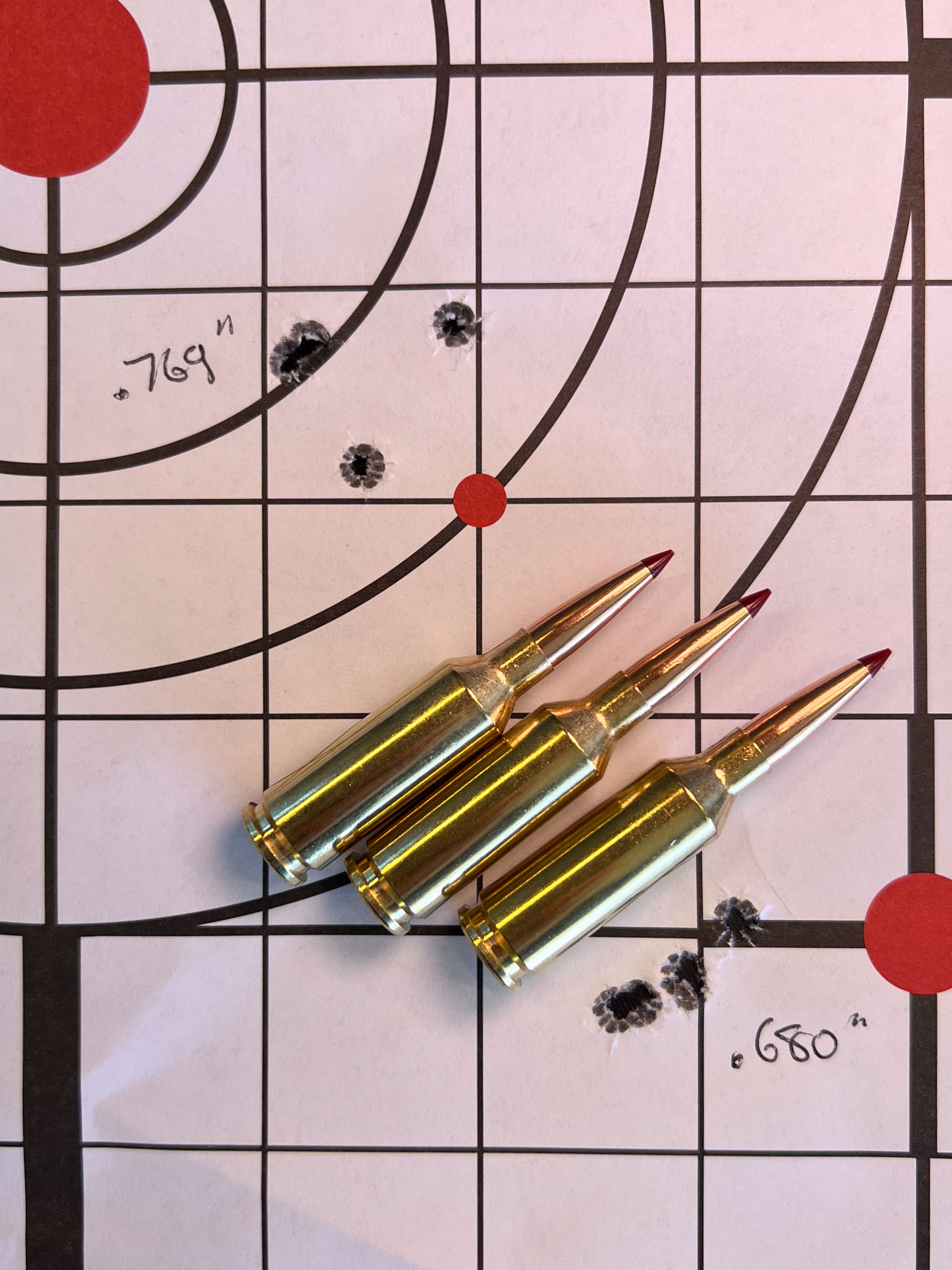
22 ARC Accuracy
Numerous rifle manufacturers have jumped on the 22 ARC bandwagon, but few rifles have been produced yet. I got a rifle from Proof Research, however, and have put a decent quantity of rounds downrange through it.
Of the three factory loads, I’ve been able to test two: the 88-grain ELD-M and the 62-grain ELD-VT. In total I’ve shot 16 groups for accuracy, following the Outdoor Life protocol of 5-shot groups at 100 yards. I shot half with the 88s and half with the 62s.
The average 5-shot accuracy at 100 yards of all the groups is .852 inches. The two bullets shot nearly identically, with the average of all groups with the 62-grain ELD-VT at .844 inches, and the average of all the 88-grain ELD-M groups at .859 inches.
One thing that stuck out at me was how consistent all the groups were. Of the 16 groups, only two measured over one inch—1.107 and 1.121 inches. The best groups were .556 inches and .614 inches. Everything else fell neatly in between.
Muzzle velocity of the two loads averaged 2713 fps for the 88-grain bullets and 3175 fps for the 62-grain ELD-VT. With the 88-grain ELD-M the extreme spreads (ES) and standard deviations (SD) averaged 43.5 and 14.3, respectively. The ES of the 62-grainers averaged 60 and the SD averaged 17.7. All these figures are good for factory-loaded ammunition.
| Rifle | Caliber | Load | Overall Group Avg. (in.) | MV | ES | SD |
| Proof Elevation | 22 ARC | Hrn 88-gr ELD-M | 0.859 | 2713 fps | 43.5 | 14.3 |
| Proof Elevation | 22 ARC | Hrn 62-gr ELD-VT | 0.844 | 3175 fps | 60 | 17.7 |
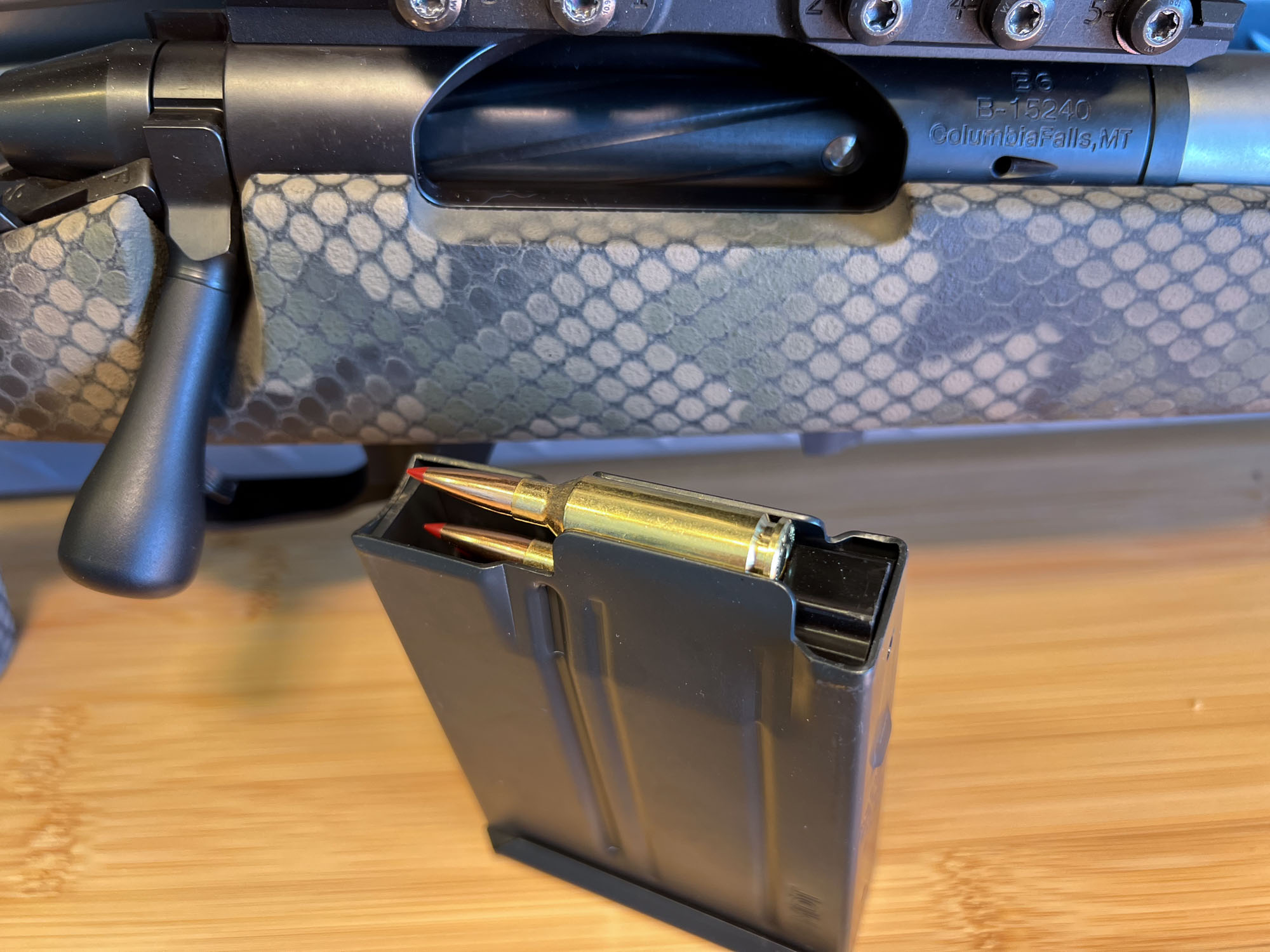
Proof Elevation MTR Test Rifle
I’ve owned and shot a handful of Proof Elevation MTRs over the years. They are stiff, capable, handy, accurate, and light. If you’re going to go with a bolt gun for a varmint cartridge, it is an excellent platform.
I did most of my shooting with a Banish Backcountry suppressor attached. Topped with a Nightforce 7-35×56 ATACR scope—a hefty but capable brute—the rifle weighed 10 pounds, 13 ounces. Shooting this rig off sandbags generated hardly any recoil.
This rifle came with a single-stack AICS magazine made by MDT that had been modified with a spacer to deal with the stubby 22 ARC cartridge. It fed the short round reliably and I had no cycling issues during the test.
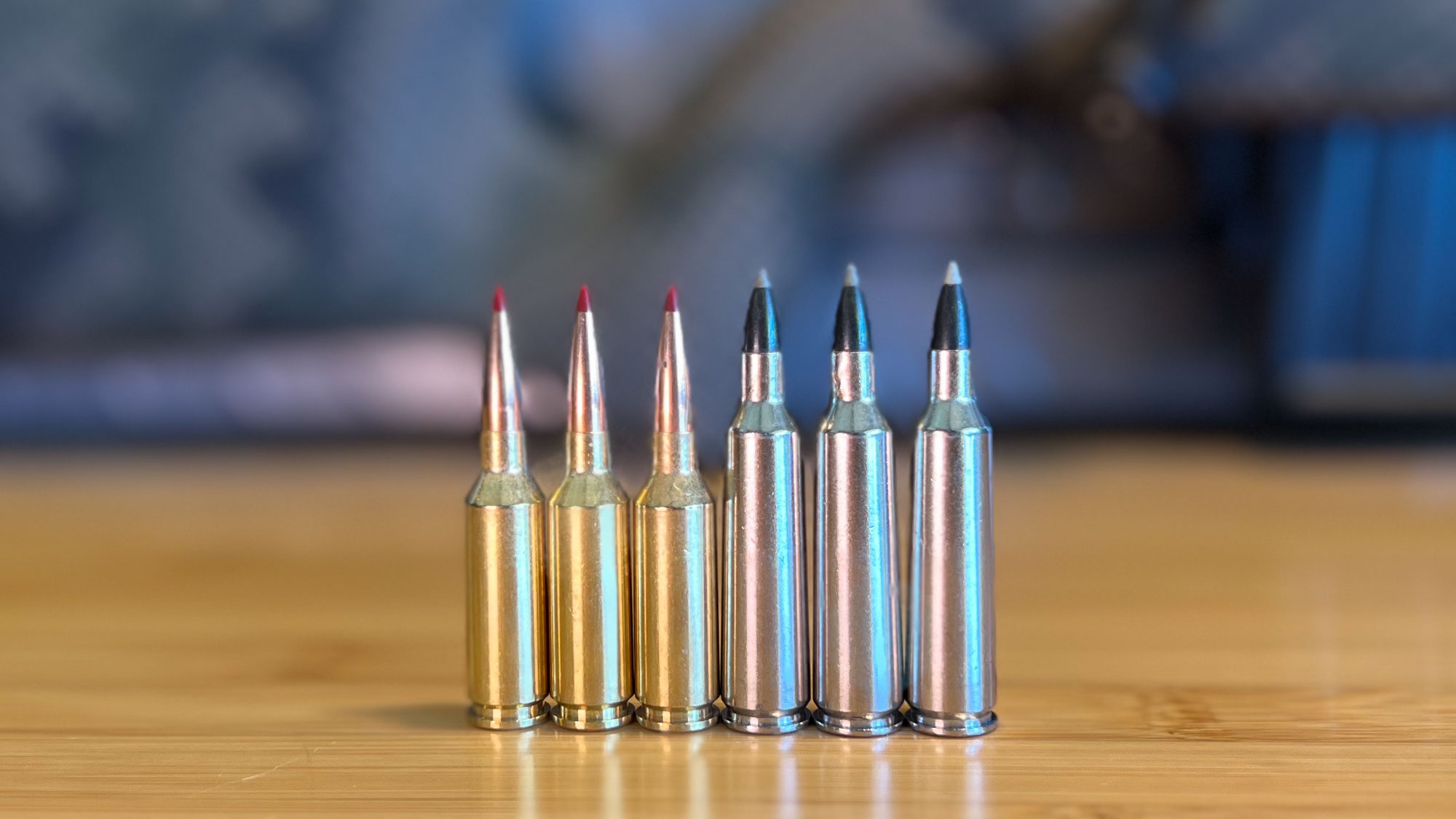
22 ARC vs 22-250 Remington
Since one of the selling points of the 22 ARC is that it performs on par with the .22-250 Remington, I wanted to compare the two a little more closely.
I’ve owned a Savage Model 12 BVSS-S for a couple decades, and that heavy-barreled single-shot .22-250 Remington has sent more prairie dogs and ground squirrels to the Great Alfalfa Field in the Sky than I can tally. (Savage no longer offers it in single-shot trim, but you can get it with a four-round magazine in the Model 12 BVSS.)
It has a 26-inch barrel with a 1:12 twist, which is actually faster than the standard 1:14 twist most old-school .22-250s come with.
That leisurely 1:12 twist is best suited for classic .22-caliber varmint bullets in the 40- to 50-grain range. It will still drive 55-grainers ok, but the precision starts to fall off. Bullets heavier than that won’t stabilize enough to deliver good accuracy and are also too long to work well in a standard .22-250 Remington chamber.
And to answer a question that is sure to occur to the more ballistically-savvy reader: No, you cannot run the 62-grain ELD-VT bullet in a .22-250. It will be too long to chamber and won’t stabilize.
This goes for all the bullets in the VT line. While they might look like a good option for legacy cartridges that predate the advent of Modern Cartridge Design because their weights are in keeping with what an older cartridge can shoot, that isn’t the case. Generally speaking, they are too long to run in cartridges like the .22-250 that were built to drive shorter, lighter bullets as fast as possible.
For this comparison, I shot some Winchester 55-grain Ballistic Silvertips and some 40-grain varmint loads from Sig Sauer.
| Cartridge | Bullet | MV | Drop and Drift in 10 mph Wind (inches) | ||||
| 200 yards | 400 yards | 600 yards | 800 yards | 1000 yards | |||
| 22 ARC | 62-gr. ELD-VT | 3175 fps | 2.2 / 2.5 | 21 / 10.9 | 64.7 / 26.9 | 143.1 / 52.6 | 271.3 / 91.4 |
| 22 ARC | 88-gr. ELD-M | 2713 fps | 3.5 / 2.4 | 29.2 / 10.4 | 85.3 / 25.1 | 181.3 / 48.1 | 330.1 / 81.4 |
| .22-250 Rem. | Win. 55-gr. BST | 3598 fps | 1.6 / 3.6 | 18.6 / 16.1 | 63.5 / 41.3 | 156.3 / 84.9 | 331.7 / 151.7 |
| .22-250 Rem. | Sig. 40-gr. Varmint | 4386 fps | .64 / 3.7 | 12.5 / 16.9 | 48.1 / 44.2 | 130 / 94 | 303.1 / 172.4 |
As you can see, the 22 ARC from the shorter barrel (20 inches versus 26 inches) does a good job hanging with the much faster .22-250. The 62-grain ELD-VT basically runs neck and neck with the 55-grain Ballistic Silvertip, until around 700 yards at which point the Hornady VT bullet runs flatter.
It isn’t until about 900 yards that the 62-grain Hornady catches up to the blazing fast 40-grain varmint bullet from Sig Sauer. And the 88-grain ELD-M lags behind them all, only besting the 55-grain .22-250 at the 1000-yard line.
But drop is just part of the story. In the wind department, which is the real key to long-range shooting, the 22 ARC beats the brakes off the .22-250 at every distance.
The radically better BCs on the Hornady projectiles give the 22 ARC greater wind forgiveness. Both 22 ARC loads have less than 11 inches of drift at 400 yards, compared to the more than 16 inches of drift in the .22-250.
At extended distances the differences become more pronounced. At 800 yards, the 22 ARC drifts about 50 inches, whereas the .22-250 loads drift 85 inches (55 grains) and 94 inches (40 grains).
These numbers paint the picture of how the 22 ARC achieves the performance goals laid out in its design.
From Russia With Love
I said the 22 ARC and 6mm ARC both come from the 6.5 Grendel, and that’s true. But going back further in time you’ll see that the original parent case for all these cartridges is none other than the 7.62x39mm, the classic Soviet AK-47 military cartridge.
The 7.62x39mm isn’t known as an inherently accurate cartridge— it was designed to be minute-of-insurgent on the battlefield—so it might seem like an odd choice where precision is a goal.
But an offshoot of the 7.62x39mm was the 5.6x39mm, also known as the .220 Russian. And that’s a different story. The .220 Russian is the most successful parent case in the history of benchrest competition.
Other rounds based on the .220 Russian include the 6mm PPC (arguably the most accurate 100- to 300-yard cartridge in the world), the .22 PPC — another benchrest standout— and others.
So you can see why the .220 Russian held appeal for Bill Alexander, who created the Grendel, and for Hornady with the 22 and 6mm ARCs.
Reloading the 22 ARC
Hornady is making 22 ARC dies—I have some on order—and the round should work well with a variety of quality powders. While I wasn’t disappointed by the accuracy of my factory ammo in the Proof Rifle, I’d wager real money that once I start reloading the 22 ARC the accuracy will improve significantly.
Powders to consider include CFE223—which runs great on progressive presses—Varget, H4350, Staball 6.5, Staball Match, and BL-C(2).
If you are running the 22 ARC through a gas gun, you’re going to want to be mindful of the SAMMI max pressure of 52,000 psi and load accordingly. If you have a bolt gun, you’ll be able to safely run at higher pressures, probably on the order of 200 fps faster than a gas gun from a given barrel length.
What the 22 ARC Does Well
The best news is that the 22 ARC achieves what it claims it does. It shoots soft, it is accurate, and it runs through AR-15 magazines and rifles. With the new VT line of bullets from Hornady it really shines for work on predators and other game.
Where the 22 ARC Could Improve
The biggest problem is availability of course. It is going to be a while before gun makers get 22 ARC chambered rifles to market in sufficient numbers. There might be a pinch on locating ammo online and at stores as well.
Final Thoughts
Whenever a new cartridge appears the most common criticism (and question) is why? What is the rationale? Why should we care? A large swath of shooters and hunters reflexively dismiss any new round because they like whatever it is they shoot, and don’t give a hoot about anything else. There’s no point in listening to those bellyachers.
But the 22 ARC does need to answer that question from curious, but understandably skeptical, shooters considering a significant outlay of money to adopt the cartridge.
After shooting it, I get it. Yes, it is a niche cartridge, and for the person who is deep into other centerfire 22s it probably won’t sway them to purchase one. But for someone who is new to varmint shooting, or who really wants to go hard into hunting with thermal scopes or who participates in competitions where you want every advantage you can squeeze from an AR-15, it has its appeal.
I doubt it will catch fire right out of the gate, but I’m guessing it is going to be with us for a good spell and will probably eclipse some of the other high-performance 22s on the market.
